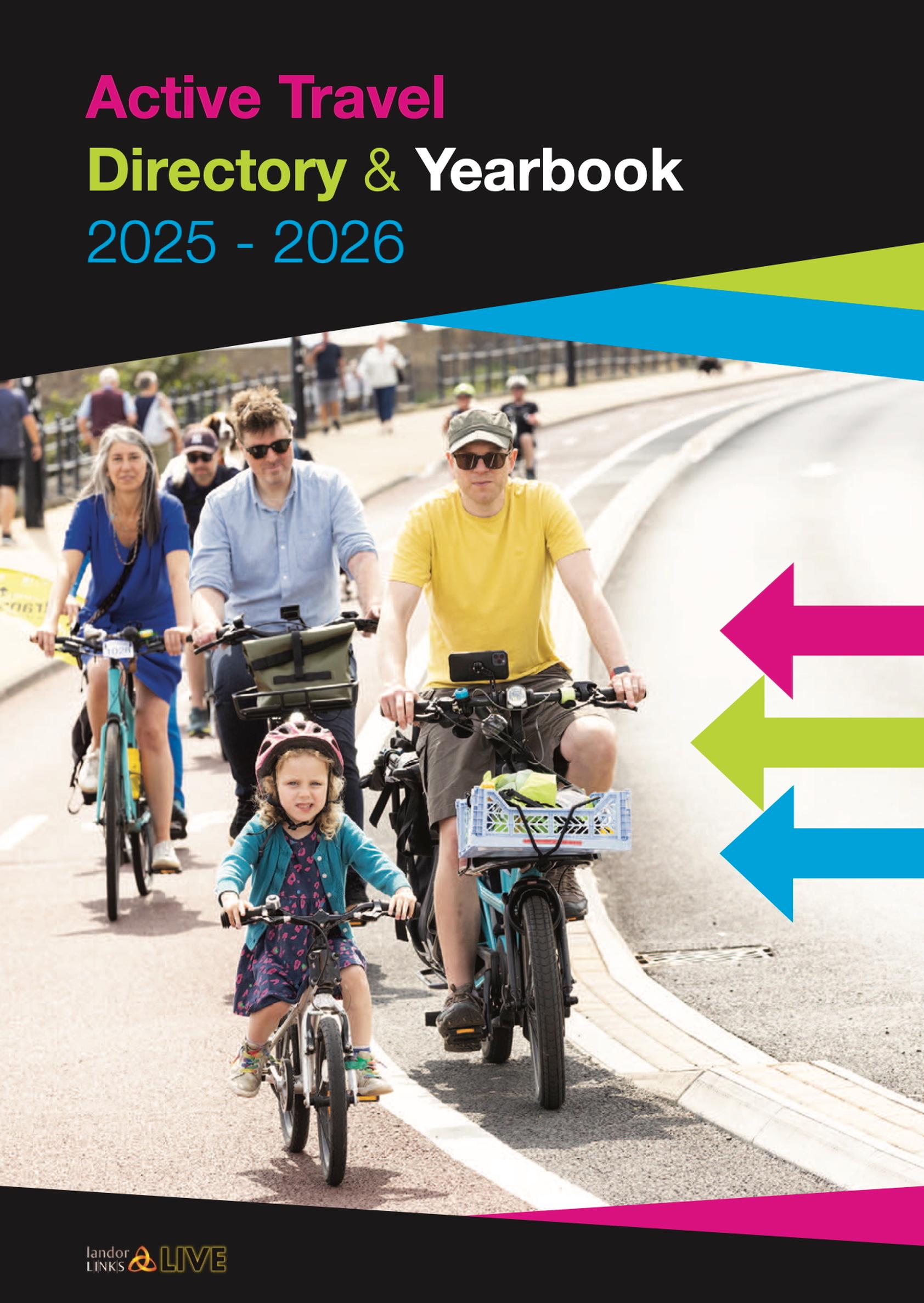

If you are involved in the world of active travel then the new look Directory & Yearbook, published by Landor LINKS, will serve as a useful reference guide.
The 60-page publication casts the spotlight on a host of inspiring projects such as North Tyneside’s 8km Seafront Sustainable Route. This separates safe space for different modes, removing the conflict that once existed when there were shared footpaths. The £11m scheme is at the heart of North Tyneside Council’s mission to encourage more people to take up active travel and adopt a healthier lifestyle.
City of York Council, meanwhile, aims to create connected networks for all modes of travel through its Movement and Place Plan. This will seek to balance the needs of streets as travel corridors and as places where people live, shop, go to school and spend leisure-time. Changes to the streetscape are set to be implemented over the next two years.
The Yearbook also reports on Edinburgh’s £23m City Centre West to East Link (CCWEL), which connects transport interchanges, businesses, neighbourhoods and the wider cycle network.
Data has revealed a big rise in cycling in the city as well a significant increase in pedestrian satisfaction on key streets. Scotland Director for Sustrans Karen McGregor describes the scheme as an “absolute game-changer within the world of active travel”.
Transformative schemes have also been implemented in Leicester city centre. The Yearbook offers details of the £10.4m Fiveways scheme. This has simplified the junction and reallocated roadspace, making it safer for pedestrians and cyclists, and it’s no longer a pinch point for buses. Leicester’s Granby Street has also undergone change. The busy shopping street now has wide, high quality footpaths, with space for outdoor café areas, as well as improved pedestrian links between the city centre and the railway station.
Change is happening in rural areas too, with projects such as the Greenway in Buckinghamshire and the Griffin Trail in Northamptonshire. Both have attracted community support, with the latter involving an alliance between North Northants Council, a landowner and a brewery. What is becoming apparent, beyond the well documented benefits of active travel, is that these schemes are also good for rural tourism.
The Yearbook celebrates the impact of eye-catching projects such as California Crossroads in Wokingham, Berkshire. The once people-unfriendly junction has been re-configured, with footway paving, carriageway leaf patterns, new planting, bespoke bollards, improved drainage and totems co-designed with local schools. Analysis of the first six months of operation reveals that the space has become an inclusive environment, safer for pedestrians and cyclists.
Inclusivity is a key consideration at Hounslow Council, with workshops and forums organised to ensure the needs of a diverse group of stakeholders are recognised in the borough’s Transport Strategy.
The National Centre for Accessible Transport (ncat) has also been working hard to “close the accessibility gap” by working with disabled people and the transport sector to remove existing barriers. Research by ncat revealed that pavements and kerbs and poorly designed and many disabled people face obstacles such as advertising signs and parked cars.
Essex Highways is taking a similar approach, working with a group of blind and partially sighted people to make active travel schemes as accessible as possible. And Lambeth Council has teamed up with MP Smarter Travel to ensure that the layout of roads, parks and transport facilities take into account the needs of people with disabilities.
Lambeth is also making steady progress in rolling out School Streets, with 90% of the borough’s primary schools set to have schemes in place by November. The council has gone a step further at St Mark’s Primary School, which is now permanently closed off to motorised traffic. This offers a glimpse of what the space outside schools could look like.
There is also a despatch from Suffolk County Council, which is just starting to deliver School Streets, with news of its first scheme at Ranelagh Primary School.
The publication also highlights why good monitoring is key to raising awareness of the projects. A case in point is the work carried out by AECOM and City of Edinburgh Council using traffic counts, air quality measurements, pedestrian and cycle monitoring, as well as community surveys to back up the case for a Liveable Neighbourhood in Leith.
There’s also a report from the Active Travel Academy (ATA) at the University of Westminster, which is leading a team to research the impact of Low Traffic Neighbourhoods. ATA researchers say that access to quality evidence is crucial. This, it argues, allow a proper assessment of complex issues such as the true impact of LTNs, the potential of cargo bikes to decarbonise the freight sector and the equity impacts of various transport policies.
A report from the Square Mile reveals how the removal of Old Street’s gyratory system has turned a once traffic-dominant area into a pedestrian and cyclist-friendly route with public spaces.
Progress is also being made in Essex, where the county council’s Active Travel team is encouraging behaviour change through a range of schemes including free bikes and repair, cycle training and e-scooter rides.
Neighbouring Kent County Council has developed a 10-year active travel network plan to identify priority routes, fill gaps and integrate with existing district level strategies. This approach is helping to accelerate the delivery of key cycling and walking schemes across the county.
On the innovations front, Cyclehoop explains how its app-based hangar booking system is allowing the public to securely store their bikes in Glasgow city centre. This is a departure from the usual arrangement where residents sign up to membership to secure a hangar space. With this new system, the public can use the app to book a space while in the city centre.
Active travel is very much a people-driven sector, so it’s fitting that the Yearbook includes profiles of two ‘champions’. Kris Radley, Active Travel Programme Manager for Essex Highways, has skilfully balanced political challenges to deliver the county’s Active Travel Fund 4 programme.
Leicester’s Jan Hudson also gets praise for her track record of delivering groundbreaking active travel projects in the city since 2009. She is described as a “hardworking, tenacious, resilient and innovative active travel advocate”.
The same accolades no doubt apply to other practitioners featured in the Yearbook. To request your free PDF email daniel.simpson@landor.co.uk or visit https://tinyurl.com/4avturw7

TransportXtra is part of Landor LINKS
© 2025 TransportXtra | Landor LINKS Ltd | All Rights Reserved
Subscriptions, Magazines & Online Access Enquires
[Frequently Asked Questions]
Email: subs.ltt@landor.co.uk | Tel: +44 (0) 20 7091 7959
Shop & Accounts Enquires
Email: accounts@landor.co.uk | Tel: +44 (0) 20 7091 7855
Advertising Sales & Recruitment Enquires
Email: daniel@landor.co.uk | Tel: +44 (0) 20 7091 7861
Events & Conference Enquires
Email: conferences@landor.co.uk | Tel: +44 (0) 20 7091 7865
Press Releases & Editorial Enquires
Email: info@transportxtra.com | Tel: +44 (0) 20 7091 7875
Privacy Policy | Terms and Conditions | Advertise
Web design london by Brainiac Media 2020